Getting Dog Used to Dog Crate (Boxing Training for Home and Away)
- Anja Boecker
- Updated: 2023-06-07
Does your dog have a hard time resting? Is long transportation stressful for him? Do you want to travel with your dog? This includes car trips to the vet and many other situations. In this article you will learn how to create a safe retreat for your dog with a kennel.
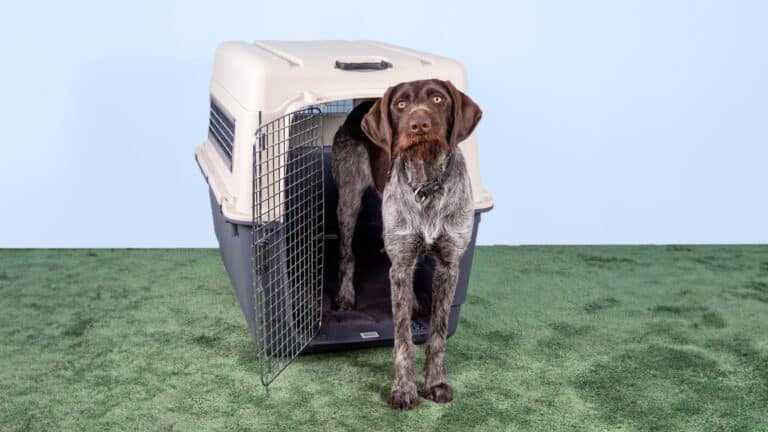
Crate training keeps your dog relaxed in any situation
The Importance of Crate Training
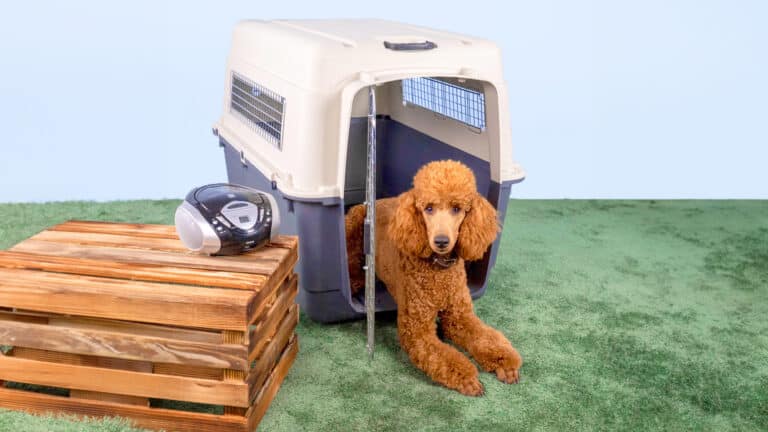
Crate training teaches you to see and appreciate the crate as a place of refuge. In this retreat, the dog feels safe and can relax.
The kennel can be used as a refuge at home or on the road, making life easier for both dog and owner.
At home, the kennel is a place of relaxation where the dog retreats from noisy visitors or too many impressions.
When traveling, the box serves as a mobile home for your dog. Your dog will always have his safe home with him in unfamiliar rooms.
When traveling by car or air, your dog must be secured for travel. If your dog likes the carrier, it will be less stressful for him.
Having a crate for your dog also has benefits for you: You can use the crate to train your dog to stay alone. A kennel that makes your dog feel comfortable will keep him relaxed and comfortable at home, in a hotel room, or in the car.
If your dog becomes agitated, you can help him calm down in the kennel. The same is true if your dog needs to rest. Some injuries or scars will only heal if the dog is not running around.
Some dogs do not like other dogs or strange dogs. In a kennel, the dog can still be in the same room with other dogs.
You can use the box to safely and comfortably remove your dog from certain situations. For example, if your dog is tearing up the furniture in your home, or is being bothered by other people.
When meeting strange dogs, the box provides a safe way to get to know them.
It is important that you never send your dog to the crate as a punishment. He should always associate the crate with positive experiences.
Training should be done slowly and with patience. Then the box can become a valuable tool in your dog's everyday life.
Choosing the Right Dog Crate
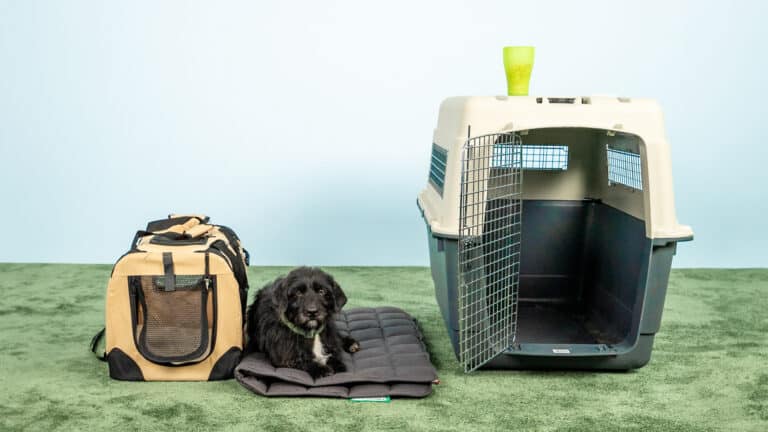
Choosing the right dog crate depends on several factors. First, the size of the crate must fit your dog. Your dog should have enough room to lie down, turn around and stand up comfortably.
Crates that are too small can be stressful for your dog, while crates that are too large may not provide a sense of security.
The type of crate also depends on your dog's needs and preferences. There are metal, plastic, and fabric kennels. Metal kennels are strong and durable, but offer less privacy.
Plastic crates are lighter and easier to transport. Fabric boxes are soft and comfortable, but not as strong.
Also pay attention to the ventilation of the box. It should have enough vents to allow the air to circulate well.
Don't forget to put a soft blanket or pillow inside the crate to keep your dog comfortable. You can also place a favorite toy or blanket inside to make the crate more familiar.
Ultimately, it's important to choose a kennel based on your dog's individual needs and comfort.
Which Boxes Should I Use?
Certain hard plastic crates are required for air travel. Please check with your airline before traveling with your dog to determine which crate you will need.
Hard plastic or aluminum crates are also suitable for car transport. These boxes are sturdy and hygienic because they are easy to clean.
For small dogs, fabric carriers are a good choice. Crates have the advantage of being easy for one person to handle.
Metal dog cages and fabric kennels are suitable for mobile housing. Fabric crates have the advantage of being lightweight.
Both types of dog kennels provide enough space for the dog and are easy to set up at home and/or in a hotel room. The advantage of metal kennels is that they are indestructible, even if your dog gets upset.
You can get your dog used to sleeping in a crate. A dog crate can be a comfortable, safe and quiet place for your dog to sleep. It gives your dog a solid place to sleep and provides structure and security.
As your dog becomes accustomed to the crate, he will be able to retreat to the crate when he needs to rest. You should make sure that the crate is always open so that your dog can choose when to go in and out.
Sleeping in the crate should never be forced. It is important that the kennel is a comfortable place for your dog and that he associates it with something positive.
The Right Place for the Dog Kennel
Where you place the box depends on your dog's needs and the layout of your home. Many dog owners place the crate in the living room because that is where they spend most of their time. This allows your dog to relax in the crate while being close to you.
The living room is often a good place to place the box. It is important to choose a quiet place where your dog is not constantly disturbed by noise or activity. The kennel should be in a place that is not too hot or too cold, and where there is enough light but not direct sunlight.
However, if your dog prefers a quieter place, the bedroom or another quiet room may also be a good choice. Some dogs like to retreat to quieter areas to sleep.
It may also be helpful to place the crate near the door if you want to get your dog used to staying in the crate when you leave the house.
Ultimately, you should choose the location that works best for you and your dog.
A Guide to Crate Training
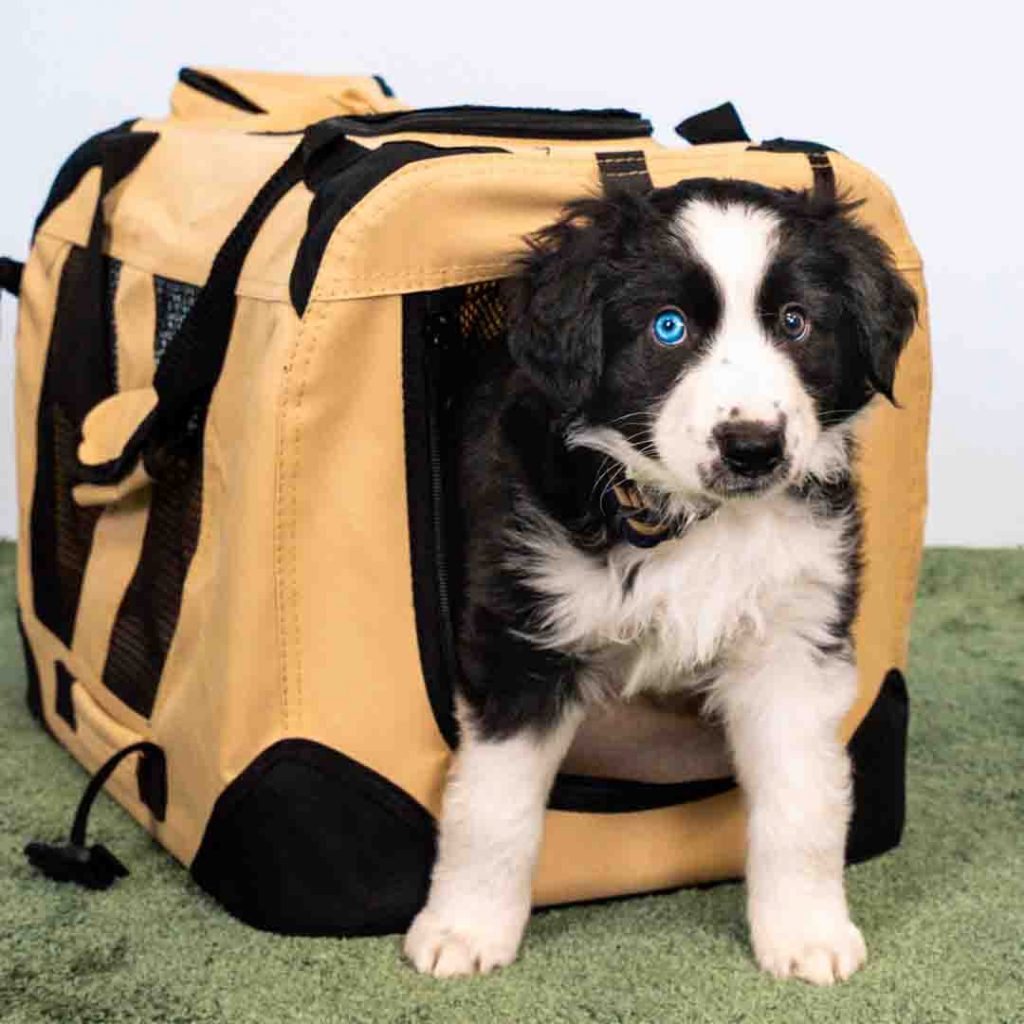
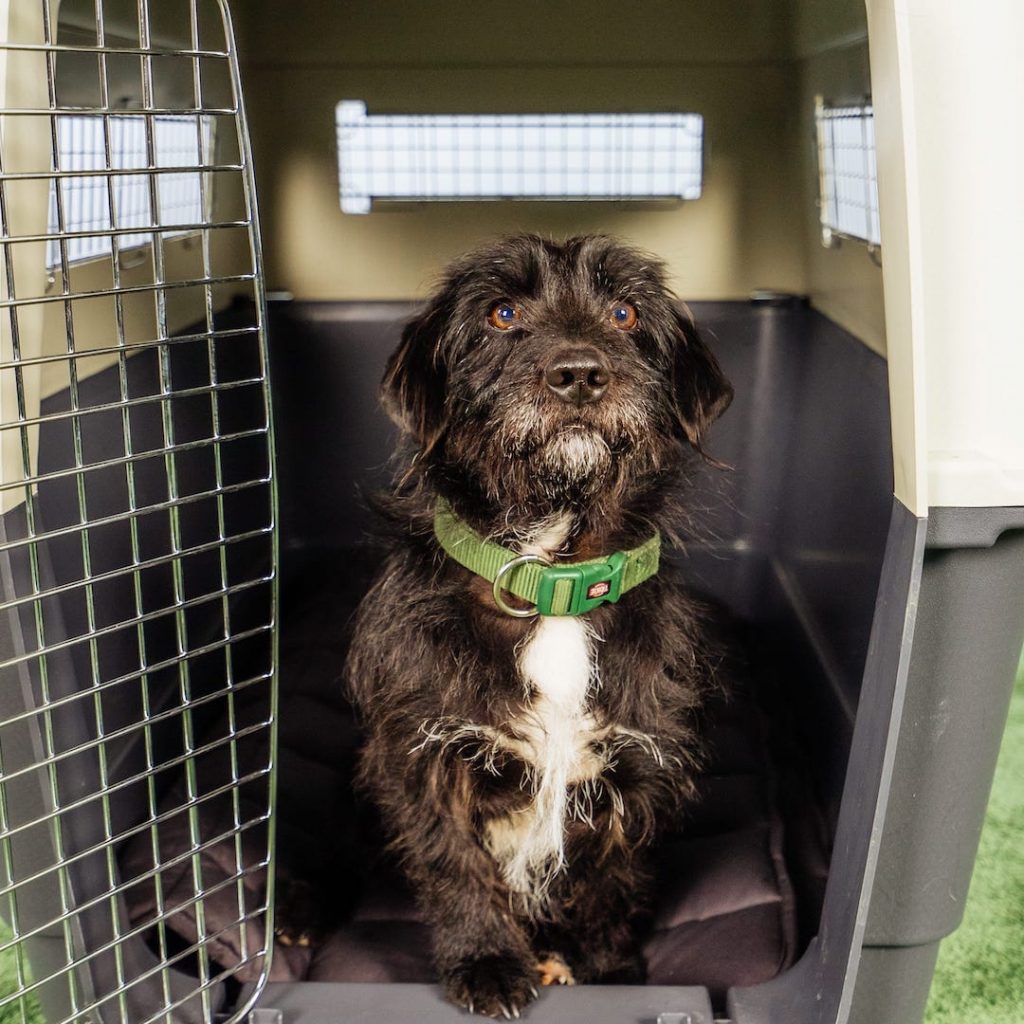
Gradually get your dog used to the litter box. Be patient and combine litter box training with positive stimuli such as praise and treats. Keep in mind that your goal is for your dog to learn to appreciate the crate as a place of refuge. This guide will help you gradually acclimate your adult dog or puppy to the crate:
1) Let Your Dog Explore the Crate
Place the open box in a room of your choice for a few days. Place treats in front of the box and praise your dog when he shows interest in the box.
2) Teaching Your Dog That the Crate Is a Good Place to Be
To get your dog to enter the crate and directly associate entering the crate with something positive, use treats again. This time, place the treat inside the crate. Place the treat in the crate: Place the treat in the beginning of the box. As training progresses, move the treat to the back of the box. Praise your dog when he enters the box.
3) Associating the Crate With a Command
When your dog enters the crate, combine step 2 with a command of your choice, such as "Box. Say the command just before your dog enters the crate. If you want your dog to learn a command to leave the crate, do the same: the moment your dog leaves the crate, say the command (e.g., "Out"). Mount: Before you place the treat in the treat box, say the command to enter the treat box. In the next step, ask your dog to enter the treat box only on command. Only when he is in the box will he get a treat.
4) Close the Crate
If your dog likes to go into the crate, you can close the crate door. Keep your dog occupied in the crate with toys or food so that he enjoys being in the crate. At first, close the door for only a short time and give your dog lots of praise. Then open the door again.
5) Keep Your Dog in the Crate Longer
Once your dog accepts you closing the crate door, increase the amount of time he spends in the crate. To do this, place toys and food in the crate that will keep your dog occupied for a long time. Food options include dried meat and chew sticks. A stuffed Kong can be used as a toy. Sit next to the crate while you train your dog to increase the amount of time he spends in the crate. Be quiet, take a nap, or read a book. If you notice that your dog is tired, ask him to go into the crate. Sit in front of the crate. Repeat this a few times. This way your dog will associate the crate with a great place to relax.
6) Getting Your Dog Used to the Crate
Your dog is relaxed in his kennel? Great! Now walk around the room in front of the crate. Walk back and forth, but stay in the same room. If your dog remains calm, leave the room for a short time. If your dog becomes agitated, sit with him in front of the crate until he relaxes. Increase the time slowly.
7) Offer Treats While in the Crate
When your dog is relaxed and resting in the crate, you can leave without putting food in the crate to keep him occupied. The treats are there to make the crate more palatable to your dog. Once your dog has learned to appreciate the crate as a place of refuge, he will no longer need treats. He may occasionally get food in the crate, but he should not expect it every time he is in the crate.
Tips for Crate Training: 6 Things To Consider
With these tips, you can make crate training a really fun activity!
1) Don't Lose Your Temper
Hectic, time pressure and stress are transferred to your dog. Practice boxing with your dog in a relaxed atmosphere. Plan enough time for boxing training. Pay attention to your own state of mind: if you are stressed, your dog will not relax. Keep training sessions short and emphasize repetition.
2) Place the Box Somewhere Quiet
Your dog will relax and rest in the kennel. Therefore, make sure the crate is located in a quiet corner of your home. Avoid a place where people are constantly walking by the crate.
3) Let Your Dog Rest in the Crate
Accept when your dog goes into the crate to relax. Leave your dog alone in the crate. Make sure family members and visitors also leave your dog alone in the crate.
4) Make the Crate Comfortable
Your dog will think of the crate as a den. To make his stay as comfortable as possible, you can put his favorite blanket in the crate. Make sure the door to the crate does not slam shut and frighten your dog. Some crates are noisy due to their material and can rattle. If this is the case, place a blanket under the crate first so your dog doesn't get scared.
5) Praise, Praise and More Praise!
Don't spare praise during crate training! Your pet will love the box because they get your approval.
6) Some Dogs Relax in Closed Crates
The closed box helps your dog to relax. He feels safe from impressions from his immediate environment, for example, children's hands. "Should I stay in the box or go outside?" - With a closed box, this question no longer occupies your dog's mind. He rests.
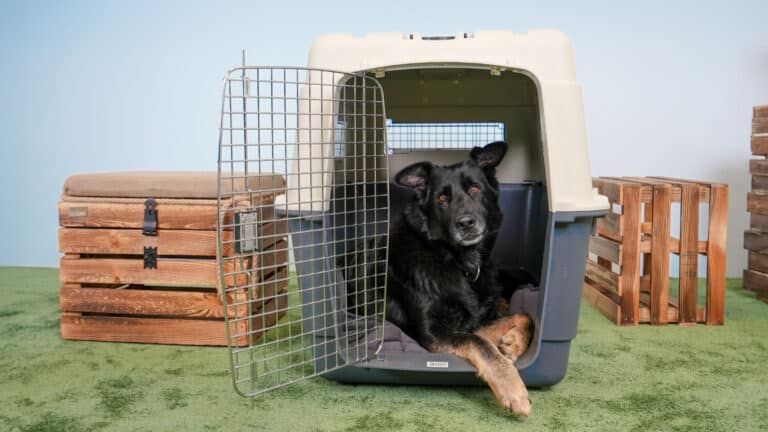
Frequently Asked Questions
The permanent keeping in a transport box is not permitted according to § 6 para. 2 of the Animal Welfare Dog Ordinance. But who keeps his dog 24 hours a day in a transport box?
A flight of ten hours is not uncommon. We humans usually sleep for eight hours. This amount of time is definitely possible, allowed and recommended. It is important that you get your dog used to spending several hours in the box during box training. This is the only way your dog can really rest and relax in the box.
Whether you let your dog sleep in a box, in a basket, or in bed with you is up to you. We recommend having the puppy sleep in a box so he and you have peace and quiet at night. Also, it is more comfortable for you or as a couple to have the bed to yourself.
You can practice sleeping in the box with your puppy. When he gets tired, you put him in the box. When he wakes up, you are with him and praise him. When he is really awake, you can take him out of the box.
In the beginning, it is recommended to put the box next to your bed at night. So he does not feel alone. When your puppy sleeps quietly in the box, you can pet him. The box is like a cave for your dog. Dogs love dens, not only for sleeping.
Get your dog or puppy used to staying in the crate with crate training. Associate the box with something positive. Use treats, food and toys. Do the box training gradually and give your dog time:
Step 1: Let your dog explore the box.
Step 2: Run it into the box.
Step 3: Connect entering the box with a command.
Step 4: Close the door.
Step 5: Increase the length of stay in the box.
Step 6: Remove yourself from the box.
Step 7: Wean your dog off the treats in the box.
For the transport in the airplane there are certain dimensions for the transport box. Please check with your airline about the prescribed size of the box. For transport in the car and as a mobile home, the box should be as large as possible.
Your dog should at least be able to sit comfortably in the box without pulling his head in. If you measure your dog, the box should be 10 to 15 cm longer and higher than your dog. Also, the box should be twice as wide as your dog. The maximum weight of the box should be equal to the weight of your dog.
No, quite the opposite: the dog learns to appreciate the box as a place of retreat, so he likes to go into the box. If your dog perceives too many impressions or feels stress, he retreats into the box to relax. With a box, you provide your dog with his own space where he feels comfortable and safe. Consider the box as a kind of cave, your dog will do the same.
From an early age, dogs are used to having their exercise space limited by humans: as puppies, they live in a whelping box or playpen. Later, they live in apartments, houses or fenced gardens. When they go for walks, they are kept on a leash. A dog crate is nothing else than a limitation of the movement space, like the leash.
Conclusion
A dog crate can be a safe and familiar place for your dog. It is especially useful when you travel or need to transport your dog.
When your dog gets used to the box, he will feel safer in unfamiliar places. The box can also help with education, for example by setting limits or serving as a resting place.
It is important that you never send your dog to the box for punishment. The box should always be associated with positive experiences. Training should be done gradually and with a lot of patience. Then the box can become a valuable tool in everyday life with your dog.
What are you waiting for? Give your dog a box as a retreat to relax and make your everyday life with your dog easier with a box. Box training is easy to implement and helps your dog learn to appreciate and love the box.

My name is Anja Boecker, and I am a certified dog trainer and behavior consultant. With these articles, I want to help you to understand your dog better and to build an inseparable bond.
Share Now:

